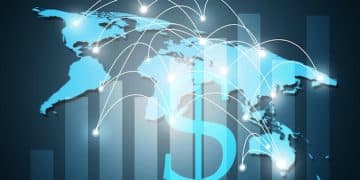Economic Forecast 2025: 2.5% GDP Growth, Opportunities, and Challenges for US Businesses

Experts anticipate a 2.5% GDP growth for the U.S. in 2025, signaling both significant opportunities for business expansion and innovation, alongside inherent challenges such as managing inflation and skilled labor shortages.
The economic landscape is a dynamic tapestry, constantly shifting and presenting new scenarios for businesses worldwide. As we look ahead, the Economic Forecast: Experts Predict 2.5% GDP Growth for 2025 – Opportunities and Challenges for Businesses emerges as a focal point for strategic planning and decision-making.
Understanding the 2025 GDP Growth Projection
The anticipation of a 2.5% Gross Domestic Product (GDP) growth for the U.S. economy in 2025 is more than just a number; it is a critical indicator that shapes the outlook for businesses across all sectors. This projection, derived from rigorous analysis by leading economists and financial institutions, provides a foundation for understanding the potential trajectory of the national economy.
GDP, in essence, measures the total value of goods and services produced within a country’s borders over a specific period. A healthy growth rate, such as the 2.5% forecast, typically signifies an expanding economy, increased consumer spending, and a more robust job market. However, behind this single figure lies a complex interplay of various economic forces, each contributing to the overall picture.
Key Drivers of the Projected Growth
Several factors are expected to underpin this forecasted growth. Consumer spending, which accounts for a significant portion of the U.S. economy, is anticipated to remain resilient. This is often fueled by a stable labor market and, in some cases, accumulated savings. Businesses are also expected to continue investing in technology and infrastructure, driving productivity gains.
- Consumer Resilience: Sustained spending patterns by households, supported by stable employment.
- Business Investment: Companies pouring capital into innovation, automation, and capacity expansion.
- Government Policies: Fiscal and monetary measures designed to stimulate economic activity without overheating.
- Technological Advancements: Continuous breakthroughs in AI, automation, and green technologies boosting efficiency.
Exports and imports also play a crucial role. A favorable global economic environment could boost demand for U.S. goods and services, contributing positively to GDP. Conversely, geopolitical tensions or trade disputes could present headwinds. The housing market, often a bellwether for the broader economy, will also be a critical component, with construction activity and home sales influencing related industries.
Understanding these underlying drivers allows businesses to better anticipate market movements and adjust their strategies accordingly. A 2.5% growth rate, while positive, also suggests a period of measured expansion rather than an explosive boom, providing a stable environment for strategic growth.
The forecasted 2.5% GDP growth for 2025 signals a period of cautious but steady expansion for the U.S. economy. This projection is influenced by robust consumer spending, strategic business investments, and the continuous evolution of technology. While generally positive, businesses must carefully analyze these drivers to capitalize on emerging opportunities and mitigate potential risks.
Opportunities for Businesses in a Growing Economy
A sustained GDP growth rate of 2.5% opens up a myriad of opportunities for businesses, prompting them to innovate, expand, and capture new market shares. This growth isn’t uniform across all sectors, making it essential for businesses to identify where the primary drivers of expansion will manifest.
Increased consumer confidence, often a byproduct of economic growth, translates into higher purchasing power and a willingness to spend on both essential and discretionary goods and services. This creates a fertile ground for retail, hospitality, and entertainment sectors.
Expanding Markets and Consumer Demand
Businesses in consumer-facing industries can expect a healthier demand environment. This isn’t just about selling more; it’s also about a more receptive audience for new products and services. Companies that have successfully pivoted during challenging times, perhaps by enhancing their digital presence or streamlining supply chains, will be well-positioned to capitalize on this renewed consumer enthusiasm.
- Retail Sector: Enhanced consumer spending boosts sales across various product categories.
- Hospitality and Travel: Increased leisure and business travel, leading to higher bookings and revenue.
- Technology Adoption: Growing demand for innovative tech solutions, including AI, cloud services, and cybersecurity.
- Sustainable Solutions: Rising consumer and regulatory interest in eco-friendly products and practices.
Furthermore, business-to-business (B2B) sectors also stand to benefit significantly. As companies grow, their need for services such as consulting, logistics, software solutions, and marketing increases. This interdependence within the economy means growth in one area often cascades into benefits for others.
The manufacturing and construction sectors are also poised for expansion. Increased business investment in infrastructure and production capacity leads to a higher demand for raw materials, machinery, and skilled labor. This also has a ripple effect on industries that supply these foundational sectors.
Innovation and Digital Transformation
The ongoing digital transformation remains a powerful force providing opportunities. Businesses that invest in automation, artificial intelligence, and data analytics can improve efficiency, reduce costs, and enhance customer experiences. This technological adoption is not merely a trend; it is a fundamental shift in how businesses operate and compete.
In addition, the focus on sustainability and environmental, social, and governance (ESG) factors offers new avenues for growth. Consumers and investors are increasingly prioritizing businesses with strong ESG commitments, creating opportunities for companies that develop green technologies, sustainable products, and ethical supply chains.
For businesses, the 2.5% GDP growth forecast represents a period ripe with potential. Expanding consumer demand, coupled with sustained business investment and the accelerating pace of digital transformation, creates a fertile ground for companies to innovate, diversify, and capture new market shares. Strategic focus on these areas will be key to unlocking significant advantages.

Challenges Businesses Might Face in 2025
While a 2.5% GDP growth forecast paints a positive picture, businesses must remain vigilant about the inherent challenges that accompany economic expansion. Navigating these complexities effectively will be crucial for sustained success and resilience.
One of the primary concerns often associated with a growing economy is inflation. As demand increases, prices for goods and services can also rise, impacting purchasing power and increasing operational costs for businesses. Managing these inflationary pressures will require careful financial planning and strategic pricing.
Inflationary Pressures and Supply Chain Resilience
The lingering effects of global supply chain disruptions, coupled with increased demand, could exacerbate inflationary trends. Businesses need to focus on building more robust and diversified supply chains to mitigate risks associated with sudden shocks or price increases in critical inputs. This involves exploring new suppliers, improving inventory management, and potentially even reshoring some production.
- Rising Input Costs: Increased prices for raw materials, energy, and labor impacting profit margins.
- Supply Chain Volatility: Potential for disruptions impacting production and delivery schedules.
- Interest Rate Hikes: Central banks raising rates to curb inflation, increasing borrowing costs.
- Geopolitical Uncertainties: Global events affecting trade, investment, and market stability.
Moreover, rising interest rates, often a tool used by central banks to control inflation, can make borrowing more expensive for businesses, potentially dampening investment in expansion or new projects. Companies with significant debt loads might find their servicing costs increasing, impacting profitability.
The labor market also presents a double-edged sword. While a strong job market is generally positive, it can lead to skilled labor shortages and increased wage demands. Businesses will need to invest in talent retention, upskilling their workforce, and potentially exploring automation to offset labor-related challenges.
Intense Competition and Regulatory Changes
Economic growth often fuels competition, as both existing players and new entrants vie for market share. Businesses must continually innovate, differentiate their offerings, and deliver superior customer experiences to stay ahead. Failing to adapt to evolving customer preferences or market dynamics could lead to stagnation.
Another significant challenge comes from the evolving regulatory landscape. Governments may introduce new regulations related to environmental compliance, data privacy, labor laws, or antitrust measures. Businesses must stay abreast of these changes and ensure their operations remain compliant, which can sometimes involve substantial investments in new processes or technologies.
Lastly, geopolitical uncertainties always loom large. International conflicts, trade policy shifts, or economic instability in key global markets can have unforeseen ripple effects on businesses operating in a globalized economy. Diversifying market exposure and maintaining contingency plans are essential strategies to navigate such uncertainties.
Despite the positive GDP forecast, businesses in 2025 will face significant hurdles, including persistent inflationary pressures, the need for increased supply chain resilience, and a fiercely competitive landscape. Navigating these challenges successfully will require proactive planning, continuous adaptation, and a strategic focus on efficiency and innovation.
Sector-Specific Projections and Insights
A 2.5% GDP growth projection for 2025 offers an overall economic outlook, but its impact will not be uniformly distributed across all sectors. Understanding these sector-specific nuances is crucial for businesses aiming to capitalize on growth opportunities or prepare for potential headwinds.
Some industries are more sensitive to economic cycles than others. For instance, sectors heavily reliant on discretionary consumer spending, such as luxury goods, travel, and certain segments of retail, often see a more pronounced boost during periods of economic expansion. However, essential services like utilities and healthcare tend to be more stable regardless of growth fluctuations.
Technology and Digital Services
The technology sector is likely to continue its robust growth trajectory, fueled by ongoing digital transformation initiatives across industries. Areas such as artificial intelligence, cloud computing, cybersecurity, and data analytics are expected to see sustained investment. Businesses in these fields can anticipate strong demand for their products and services as companies seek to enhance efficiency and competitiveness.
- AI and Automation: Increased adoption across various industries for operational efficiency.
- Cloud Services: Continued migration to cloud platforms for scalability and cost-effectiveness.
- Cybersecurity: Growing demand for robust solutions as digital threats evolve.
- E-commerce and Digital Marketing: Sustained growth in online retail and digital consumer engagement.
The shift towards remote and hybrid work models will also continue to drive demand for collaboration tools, connectivity solutions, and hardware upgrades. This creates opportunities for IT service providers, software developers, and electronics manufacturers.
Manufacturing, particularly in advanced sectors, is also expected to benefit from increased business investment and potential re-shoring efforts aimed at strengthening supply chains. Industries involved in sustainable technologies, such as renewable energy and electric vehicles, are projected to experience significant growth due to policy support and consumer demand.
Healthcare and Biotechnology
Healthcare is a relatively resilient sector due to its essential nature, but it will also experience growth driven by an aging population and advancements in medical technology. Biotechnology, pharmaceuticals, and health tech firms will likely see continued investment and innovation. Areas like personalized medicine, telemedicine, and preventative care could expand significantly.
On the other hand, sectors like traditional retail, which have been struggling with e-commerce competition, may still face challenges despite overall growth. They will need to continue adapting their business models, focusing on omnichannel strategies and unique in-store experiences.
Financial services, while benefiting from increased economic activity, will also need to navigate potential interest rate fluctuations and evolving regulatory landscapes. Real estate markets will vary by region, influenced by local demand, interest rates, and construction activity.
The 2.5% GDP growth in 2025 will create varied impacts across sectors. Technology, digital services, healthcare, and advanced manufacturing are poised for significant expansion, driven by innovation and strategic investments. Conversely, sectors like traditional retail may need to further adapt, highlighting the importance of tailored strategies based on specific industry dynamics.
Strategic Planning for Business Resilience
In an economy forecasting 2.5% GDP growth, strategic planning moves beyond merely seeking expansion; it encompasses fostering resilience. Businesses must develop agile strategies that allow them to capitalize on opportunities while simultaneously mitigating potential downturns or unexpected challenges.
The concept of resilience in business today transcends simply surviving economic shocks. It involves building adaptability into every facet of operations, from financial management to human resources and supply chains. Proactive planning ensures that businesses are not reactive to market shifts but are instead prepared for them.
Financial Fortitude and Cash Flow Management
Maintaining strong financial health is paramount. This means focusing on robust cash flow management, building adequate reserves, and diversifying funding sources. While growth can tempt businesses to overextend, prudent financial management ensures they can weather unforeseen expenses or revenue fluctuations.
- Diversify Revenue Streams: Reduce reliance on a single product, service, or customer segment.
- Optimize Cost Structures: Continuously review and streamline operational expenses without compromising quality.
- Scenario Planning: Develop strategies for various economic outcomes, including slower growth or recession.
- Foster a Culture of Adaptability: Encourage innovation and flexible decision-making at all levels.
Investing in technology that enhances efficiency and reduces operational costs is another critical component of resilience. Automation, predictive analytics, and enterprise resource planning (ERP) systems can provide better insights, streamline processes, and improve decision-making, making businesses more robust against market changes.
Supply chain resilience, as discussed earlier, is no longer a niche concern but a strategic imperative. Businesses should map their supply chains, identify single points of failure, and develop alternative sourcing strategies. Building stronger relationships with key suppliers and exploring localized production can also reduce vulnerability.
Talent Management and Workforce Agility
A skilled and adaptable workforce is a cornerstone of business resilience. Investing in employee training and development ensures that the team has the necessary skills to navigate evolving market demands and technological advancements. Creating a positive work environment fosters retention and attracts top talent, crucial during periods of economic growth and associated labor shortages.
Furthermore, businesses should embrace a culture of continuous learning and innovation. Encouraging employees to experiment, providing feedback, and allowing for controlled failures can lead to breakthroughs and keep the company at the forefront of its industry. This internal agility is critical for responding to competitive pressures and seizing new market opportunities.
Finally, robust risk management frameworks are essential. This involves identifying potential risks—be they economic, operational, regulatory, or reputational—and developing strategies to mitigate them. Regularly reviewing and updating these frameworks ensures their continued relevance.
Strategic planning for business resilience in 2025 revolves around financial prudence, technological integration, robust supply chains, and a highly adaptable workforce. By embedding these principles into their core operations, businesses can not only navigate a 2.5% GDP growth environment but also withstand unforeseen challenges, ensuring long-term stability and success.
Investment Trends and Capital Allocation
The projected 2.5% GDP growth for 2025 will inevitably influence investment trends and how businesses allocate their capital. Understanding these shifts is crucial for both established companies and emerging enterprises looking to secure funding and effectively deploy their resources.
Economic growth often spurs confidence, leading to increased capital expenditure. Businesses may prioritize investments that enhance productivity, expand capacity, or develop new products and services. The nature of these investments, however, will be heavily influenced by broader market trends and technological shifts.
Focus on Sustainable and Digital Investments
A prominent trend in capital allocation will likely be continued investment in digital transformation. Companies are increasingly prioritizing technologies that offer long-term efficiency gains, such as artificial intelligence, machine learning, and cloud infrastructure. These investments are no longer considered optional but fundamental for maintaining competitive advantage.
Another significant area for capital allocation will be sustainability and ESG (Environmental, Social, and Governance) initiatives. Investors and consumers are placing greater emphasis on companies with strong ESG credentials, compelling businesses to invest in renewable energy sources, sustainable supply chains, and ethical labor practices. This isn’t just about compliance; it’s about building long-term value and attracting a new generation of conscious customers.
Venture capital and private equity firms will likely continue to seek out innovative startups, particularly in high-growth sectors like biotech, clean energy, and fintech. Companies looking for external funding should align their business models with these key investment trends to increase their chances of securing capital.
Furthermore, with potential inflationary pressures, businesses might also allocate capital towards hedging strategies or building stronger inventory reserves to mitigate supply chain risks and volatile input costs. Real estate investments, while sensitive to interest rates, could also see selective growth in areas supported by population shifts or industrial expansion.
The 2.5% GDP growth in 2025 will shape investment trends, with a pronounced focus on digital transformation, sustainable initiatives, and strategic capital allocation to bolster resilience. Businesses should align their investment strategies with these prevailing trends to secure funding, enhance competitiveness, and drive long-term value in an evolving economic landscape.
Market Adaptation and Innovation Strategies
In an environment of forecasted 2.5% GDP growth, market adaptation and continuous innovation are not merely desirable attributes but essential survival mechanisms for businesses. The ability to pivot, reimagine business models, and embrace new technologies will distinguish thriving enterprises from those struggling to keep pace.
Adaptation involves more than cosmetic changes; it requires a deep understanding of evolving consumer behaviors, technological advancements, and competitive pressures. Innovation, on the other hand, is the engine that drives differentiation and opens up new revenue streams.
Responding to Consumer Behavior Shifts
Consumer preferences are constantly evolving, influenced by factors such as digital convenience, sustainability concerns, and personalized experiences. Businesses must invest in market research and data analytics to gain real-time insights into these shifts. This allows for the agile development of products, services, and marketing strategies that resonate with target audiences.
- Agile Product Development: Rapid iteration and launch of products based on market feedback.
- Customer Experience (CX) Focus: Prioritizing seamless and personalized customer journeys.
- Data-Driven Decision Making: Leveraging analytics to inform strategy and optimize operations.
- Partnerships and Collaborations: Seeking strategic alliances to expand market reach or capabilities.
The rise of e-commerce and omnichannel retail continues to demand flexible sales and distribution channels. Businesses need to ensure a cohesive and seamless customer journey whether through online platforms, brick-and-mortar stores, or mobile applications.
Innovation isn’t limited to product development; it extends to business processes, operational efficiency, and organizational culture. Implementing automation, for example, can free up human capital for more strategic tasks, fostering a more innovative workforce.
Embracing Emerging Technologies
The rapid pace of technological advancement, from artificial intelligence and blockchain to virtual reality and the Internet of Things (IoT), presents both opportunities and disruptions. Businesses that proactively explore and integrate these technologies into their operations can gain significant competitive advantages. This might involve investing in R&D, partnering with tech startups, or acquiring companies with specialized technological capabilities.
A key aspect of market adaptation is also the promotion of a culture of continuous learning and experimentation within the organization. Employees at all levels should feel empowered to identify problems, propose solutions, and test new ideas. This fosters internal innovation and ensures the company remains dynamic and responsive.
Lastly, strategic partnerships and collaborations can be powerful tools for adaptation and innovation. By joining forces with other businesses, startups, or academic institutions, companies can access new markets, technologies, or expertise, accelerating their ability to innovate and adapt to a changing economic landscape.
In a growing economy, market adaptation and innovation are crucial for businesses. This involves a proactive stance on understanding evolving consumer behaviors, embracing disruptive technologies, and fostering an internal culture of continuous learning and experimentation. Such strategies will be vital for sustained competitiveness and growth in 2025 and beyond.
| Key Area | Brief Description |
|---|---|
| 📈 GDP Growth | U.S. economy projected to grow by 2.5% in 2025. |
| 💡 Opportunities | Increased consumer demand, digital transformation, sustainable solutions. |
| ⚠️ Challenges | Inflationary pressures, supply chain risks, skilled labor shortages. |
| 🛡️ Strategies | Financial prudence, tech investment, supply chain diversification, talent management. |

Frequently Asked Questions
▼
For average consumers, a 2.5% GDP growth generally means a healthier job market with more employment opportunities and potentially higher wages. It also signals increased consumer confidence, which can lead to more spending on goods and services, improving overall living standards. However, it may also bring inflationary pressures, affecting purchasing power.
▼
Inflation can significantly impact business profitability by increasing operational costs, including raw materials, labor, and transportation. While GDP grows, companies might face pressure to raise prices, potentially affecting consumer demand. Businesses will need robust strategies for cost management, supplier negotiations, and pricing decisions to maintain margins.
▼
Sectors poised to benefit most include technology and digital services due to ongoing digital transformation, healthcare and biotechnology driven by aging demographics and innovation, and advanced manufacturing. Consumer-facing industries like retail and hospitality may also see a boost from increased consumer confidence and spending.
▼
Key risks include persistent inflationary pressures leading to higher interest rates, continued disruptions in global supply chains, and intense competition across industries. Geopolitical uncertainties and a tight labor market with skilled worker shortages also pose significant challenges, requiring businesses to adapt and innovate constantly.
▼
Small businesses should focus on financial resilience by maintaining healthy cash reserves and diversifying revenue streams. Investing in digital capabilities, enhancing customer experience, and building adaptable supply chains are crucial. They should also prioritize talent retention and explore strategic partnerships to mitigate risks and capitalize on growth opportunities effectively.
Conclusion
The comprehensive Economic Forecast: Experts Predict 2.5% GDP Growth for 2025 – Opportunities and Challenges for Businesses paints a picture of controlled expansion for the U.S. economy. While the positive GDP projection offers fertile ground for growth and innovation across multiple sectors, it also necessitates a proactive approach to potential challenges like inflation, supply chain vulnerabilities, and a competitive landscape. Businesses that prioritize financial prudence, digital transformation, talent development, and agile market adaptation will be best positioned to not only thrive but also sustain their success in this dynamic economic environment.





